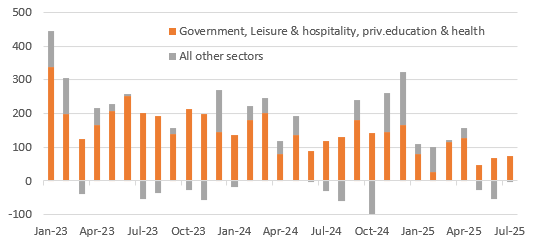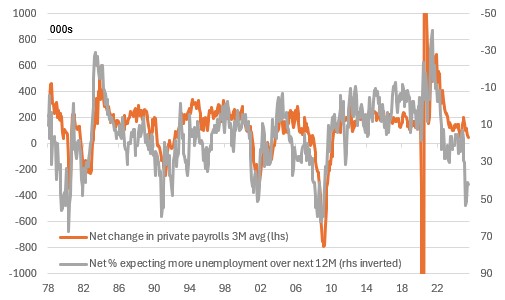We’re changing our call on the Fed. The pressure to is intensifying as the US jobs market and the growth story are no longer looking quite so solid. While prices will rise due to tariffs, we don’t see long-term inflationary pressures and believe the Fed may well start cutting rates from next month
Weak Jobs and Cooling Growth Point to Earlier Fed Rate Cuts
How quickly things can change. And here’s why we’ve changed our minds on what the Fed will likely do next. Friday’s US was a wake-up call.
Our view had been that while economic growth was likely to slow in the near term in response to the uncertainty generated by President Trump’s policy mix of trade tariffs, targeted spending cuts and immigration controls, the jobs market was looking resilient. Monetary policy was mildly restrictive, but in an environment where tariffs will push up prices, we doubted the Fed would be in a rush to cut interest rates despite pressure from the President.
We felt that by the time of the December FOMC meeting, they would have had evidence of cooling month-on-month price increases. This would confirm elevated inflation rates would not be sustained, and with unemployment likely creeping a little higher by that point, they would have room to cut rates 50bp in December and follow up with a further 75bp in early 2026.
After last Wednesday’s FOMC meeting, we were still pretty happy with that call. Yes, two members – Governors Chris Waller and Michelle Bowman – voted for an immediate 25bp cut, but with the economy and jobs market described by Chair Jerome Powell as “solid”, the rest of the committee appeared in no rush to ease policy.
Moreover, Powell set himself on a renewed collision course with the President by suggesting that it could be viewed that the Fed are “looking through” tariff-induced goods inflation by not “raising” rates. This left the markets pricing just nine basis points of a potential September 25bp cut with a mere cumulative 33bp of cuts priced for the whole of 2025.
Friday’s jobs report and subsequent weak business surveys have changed all that. July’s mediocre headline of 73k is one thing, but the quarter of a million downward revision to payrolls for just two months suggests a clear loss of momentum and that the jobs market is not nearly as “solid” as believed.
It is even worse than that when we consider that 89% of all jobs added in the past 31 months (since January 2023) have now come from private education & healthcare services, government and leisure & hospitality sectors that are less well paid, less secure and more part-time in nature than ’typical’ US jobs.
All other sectors, which make up the bulk of the US economy, have posted net losses in each of the past three months.
Monthly Change in US Non-Farm Payrolls (000s)

Source: Macrobond, ING
Little Comfort in Other Data
Consumer perceptions of the jobs market are even weaker than suggested by the official data. The Conference Board measure of whether jobs are plentiful or are hard to come by is consistent with the rising above 5% with the University of Michigan’s measure of unemployment expectations suggesting that the fear of job losses has only been greater on five occasions in the past 50 years.
Workers see and feel changes in the job market before they show up in the official data, and these pessimistic readings do not look good for consumer spending, the main engine of US economic growth.
UoM Survey of Consumer Unemployment Expectations Points to the Sense of Outright Job Losses

Source: Macrobond, ING
This has since been followed up by subdued and surveys, consistent with growth slowing towards 1% year-on-year in the second half of the year and construction spending falling for eight months out of the past ten. Second-quarter GDP growth on the headline level appeared strong at 3%, but this was boosted by a collapse in imports following the surge in the first quarter as companies sought to build inventories and avoid tariffs.
Domestic demand was weak, with consumer spending rising just 1.4% quarter-on-quarter, annualised, non-residential fixed investment increasing 1.9%, and residential investment falling 4.6% with increases in local and state government expenditure offset by cuts in federal spending.
Inflation Is Unlikely to Be as Bad as Feared
However, many at the Fed worry that will be lifted by tariff-related price hikes, with uncertainty over how long it may persist. Officials were stung by the criticism they received after suggesting that price rises following the post-pandemic supply shock would be “transitory”, only for inflation to hit 9% in 2022; they don’t want to make the same mistake again.
We don’t think they need to worry too much, though. Yes, we likely run the risk of 0.4% MoM or even the odd 0.5% MoM and readings over the next three to four months as the effects of tariff pass-through to the consumer become apparent. But we strongly believe this is a one-off step change in prices rather than something that will be more prolonged and lift annual inflation rates back above 4% well into 2026.
Services dominate the inflation basket by weighting, and here the situation is very different to 2021/22. Remember that tripled over that period, house prices and housing rents surged, while the jobs market was red hot with desperate hiring practices resulting in record employee turnover as wages soared.
This all helped to amplify and extend the post-Covid supply-shock-related increase in goods prices. Today, these are all disinflationary influences, with cooling housing rents in particular set to help offset the effect of tariffs over the coming quarters.
Housing Rents Point to Cooler Service Sector Inflation Readings (YoY%)

Source: Macrobond, ING
Fed Set to Cut Three Times This Year
Chris Waller and Michelle Bowman published statements just half an hour before last Friday’s jobs report, commenting that they felt the Fed was being “overly cautious” with the risk that policy is “falling behind the curve”.
That view is seemingly spreading with San Francisco Fed President Mary Daly commenting this week that two cuts for 2025 had been her central case, but after the latest data, “the more likely thing is that we might have to do more than two”. Given the Fed’s dual mandate of achieving price stability and maximum employment, we suspect that the obvious loss of economic momentum means that more officials are starting to think similarly.
As such, we expect a consensus to build within the Fed that they can move policy from “somewhat restrictive” territory closer to neutral at the September FOMC meeting. We do have another jobs report and two more inflation releases before then, but we will need to see some firm numbers to delay a cut.
Market expectations have already shifted, with 23bp of cuts now priced for September and a cumulative 59bp priced by the December FOMC meeting. If the Fed cuts in September, as we now believe, that is unlikely to be the end. We suspect they will look to get rates below 4% by the end of the year, so follow up with 25bp cuts in October and December, and then take stock of the situation.
This would leave the policy rate range at 3.75-3.5%, above the 3.00% level the Fed continues to project the Fed Funds rate will average over the ’longer run’. We are then projecting 50bp of in early 2026, so we are not changing our prediction for the terminal rate at this stage.
That said, a new Fed Governor is set to be named to replace the imminently departing Adriana Kugler. That person may end up being President Trump’s nominee for Fed Chair once Jerome Powell’s term ends next May. With Powell also expected to step down from the Board of Governors at that point and needing to be replaced, the Fed is going to be leaning more dovishly from the second quarter of 2026 onwards. This suggests the possibility of deeper, faster interest rate cuts than we are currently forecasting in 2026.
Disclaimer: This publication has been prepared by ING solely for information purposes irrespective of a particular user’s means, financial situation or investment objectives. The information does not constitute investment recommendation, and nor is it investment, legal or tax advice or an offer or solicitation to purchase or sell any financial instrument. Read more

